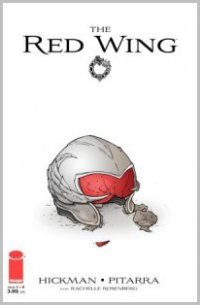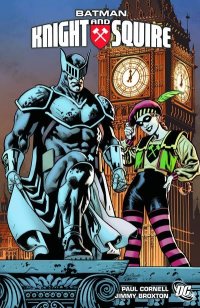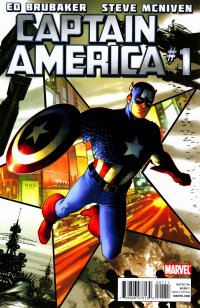The Red Wing #1 (Image, $3.50)
By Adam Prosser
It’s become a much-bemoaned fact—and correctly so, I think—that far too many indie comics have become stepping stones rather than ends in themselves. For whatever reason, comics fans seem to have become reluctant to buy anything that doesn’t come pre-branded with their favourite characters, meaning that the truly original comics tend to exist only so that their creators can gain a more lucrative job working for DC or Marvel, at which point they’re frequently cast aside—usually more out of necessity than desire on their creator’s part, but the results are the same.
For that reason, God bless Jonathan Hickman. The guy made his name with a series of distinctive indie comics at Image—most notably the assaultive The Nightly News–and now even while he’s “graduated” to writing perhaps the most interesting run on the Fantastic Four since Lee and Kirby were in charge of the title, he’s still producing creator-owned books for, apparently, the sheer love of it. The Red Wing is the latest offering in Hickman’s distinctive style, and now that Hickman’s profile has expanded, perhaps it’ll be a legitimate success…
Sometime in the 23rd century, mankind invents time travel and uses it to fight a devastating war across history. While the rules haven’t been spelled out yet, it seems as though the mechanics of time travel mean that paradoxes are essentially impossible, which means that the two sides—whoever they are—are free to wreak havoc throughout history, conducting elaborate dogfights among dinosaur-infested swamps and ancient Greek forums, with little heed to the devastating fallout. Having your “chronal shielding” knocked out means that the “time shear” will age you to dust in a second, so ejecting from your craft is apparently a million-to-one shot at survival; hence, the danger involved makes standard top gun fighter pilots look like sissies. Dominic Dorne is a newbie fighter recruit whose father died in precisely such a crash, and is haunted by this knowledge as he prepares to embark on his own piloting career. What Dominic doesn’t know, though, is that his father did, in fact, survive his crash on that million-to-one shot and is now making his way back through time to his son.
Hickman’s earlier work was challenging and dense, often resembling a polemic more than a story. Starting with Red Mass For Mars, his work became rather more conventional (inasmuch as it stopped including elaborate infodump captions and used more standard panel layouts rather than the elaborately designed pages Hickman relied on for Nightly News and Pax Romana) though still dense with ideas. I can’t help but notice that The Red Wing is perhaps his most accessible work; although there’s a density of story, it unfolds in a more straightforward fashion, rarely throwing ideas at you without explanation, and with the basic premise laid out fairly clearly at every step. And while there’s a few Big Ideas here—the main one being that a time war, for all the dogfighting, is fought mostly on ideological grounds rather than physical ones—this is still, at heart, a simple story of war and survival.
If you haven’t discovered Hickman’s work, I can’t think of a better place to start…which may very well be his intention. It’d certainly be nice if Hickman could win some converts from his Marvel work to pay attention to some of the most bold and inventive comics being made at the moment.
Rating: 




Out of a Possible 5 Stars
 Batman: Knight and Squire tpb (DC Comics, $14.99)
Batman: Knight and Squire tpb (DC Comics, $14.99)by Graig Kent
I am an avid viewer of British programming to the point that at least half of my top ten all-time favourite television shows are products of England. I like the British sense of humor, and I enjoy their patience with higher-concept science fiction and fantasy. For the same reason, many of my favorite writers (comic scribes and novelists alike) are from the UK. Perhaps not for the same reason, I also like a lot of British music. I was heavily into the Brit-Pop revival of the 1990’s and until recently was still keeping tabs on the scene across the pond. I wouldn’t necessarily consider myself an Anglophile, but I guess in the strictest definition I am.
I don’t think you have to be an Anglophile to enjoy Knight and Squire, but it would definitely help.
I’ll be honest, I didn’t care all that much for the British Batman and Robin upon first, second, fifth and twelfth introduction to them, almost all (if not all) in the pages of something or other their rejuvenator Grant Morrison was working on. These characters (moreover their monikers) have a long, but shallow, history in the DCU, never popular and rarely seen, most likely because, like me, most readers found it hard to really care about a foreign knock-off when the originals are so damn great. Plus, if you look at the history of storytelling in comics, the characterization of incidental characters were rather thin, and foreign characters were so often painfully stereotypically written. Despite my overwhelming appreciation for Mr. Morrison’s talent, at no time had he handled Knight and Squire in any capacity that I ever truly cared or appreciated them. In fact, I seem to recall my reaction their appearance in JLA Classified #1-3 was general disdain.
How the tides have turned. With Batgirl #22 last month, written by Brian Q. Miller in which Batgirl teams up with Squire, I developed an embarrassing affection towards young Beryl “Squire” Hutchinson and the recently release trade paperback of the Knight and Squire mini-series immediately became mandatory reading. And what an overwhelming joy it is. In the series writer Paul Cornell doesn’t just develop the characters and their secret identities, but rather he develops an entire identity for the United Kingdom superhero community, and even if you drowned it in Twinings tea it couldn’t be more British.
Each of the six chapters ends with postscript from Cornell providing a non-British audience with a guide to, relatively speaking, a scant few of its voluminous Britishisms, but in the last two chapters, he goes on at length to point out the nearly 200 individual superheroes and supervillains he an illustrator Jimmy Broxton created to fill out the environments Knight and Squire find themselves in. Those noted don’t even include the many supporting cast members, like the townspeople from the hamlet where Beryl and Cyril live. It’s an impressively rich world that this dynamic duo inhabit (one must also take note of the tossed away mentions of the legacy that Knight and Squire carry, as it really gives the characters an iconic sense that I’d never considered before), and what’s more it’s it’s nothing like Gotham. The world of Knight and Squire is relaxed, sunny even, though dark things do happen, they’re taken with dry wit or a stiff-upper-lip. As any Anglophile would expect, the centerpiece of K&S isn’t their version of the Batcave (although they do have one, trophy room an all), but instead a pub, enchanted so that heroes and villains alike can gather without any dust-ups and just enjoy a pint. Also in the UK, the idea of a “secret identity” is a relaxed one. Even if people don’t know who is under that mask, it wouldn’t be terribly difficult to figure out, but most people turn a blind eye to such a thing and leave Beryl and Cyril to their private business. Though they are professionals, and often are called upon to use the skills they’ve learned or inherited, just as often the everyday shopkeep can be just as effective in dealing with spandex-clad criminals.
Broxton’s art doesn’t make for the prettiest looking superheroes, but the man can develop a visual world like nobody’s business. He doesn’t so much pack in the detail as he does illustrate what’s necessary to get a feel for where the characters are and to place the reader within decidedly British trappings. One might complain that Broxton and Cornell get too British with the series, alienating a casual reader who might only be looking for action and not so many colloquialisms or nods to foreign culture, and to that I say poppycock. Even if future stories featuring the characters don’t lay it on so thick, that this mini-series-turned-paperback does is almost a necessity to really define the British side of the DC Universe, a side that has, quite honestly, been rather ignored for most of DC’s publishing history.
I should also note that Knight and Squire was not among the 52 new “number 1” titles debuting in DC’s September relaunch, but, perhaps, if we’re lucky, Cornell (or hey, even Brian Q. Miller) and Broxton will be back with more in the future.
Rating: 




Out of a Possible 5 Stars
Strange Adventures #1 (Vertigo, $7.99)
By Graig Kent
I get it. It’s the Internet age. You want to know something, you google it (or bing it or yahoo it or whatever your preference it) and in all likelihood you will find the answer you’re looking for (and maybe a few you’re not). But even still,as savvy as we have gotten as a society — global culture even — that doesn’t excuse a printed publication, specifically a comic book, from identifying somewhere, anywhere, within it’s pages whether it is a one-shot, an ongoing, or a limited series.
For the second time, Vertigo has resurrected DC’s old space anthology for the modern day Here they enlist a diverse cast of mainstream, alternative and international creators to contribute SF-based short stories… or at least I think they’re all short stories, it’s kind of hard to tell with some of them, as a fee do not seem definitively concluded or they’re so intricately realized it seems somewhat unreal a writer would put in all that work for 8 pages. As well, the cover features the hyperbolic proclamation –“Featuring the first chapter of the new series Spaceman! from the Eisner Award-winning 100 Bullets Brian Azzarello and Eduardo Risso!” — which confuses things a bit. Is it a forthcoming separate title or is it the first chapter of an ongoing story in an ongoing Strange Adventures anthology?
A quick search of the ‘net finds Spaceman is a mini series slated for later this year, and Strange Adventures is a one-shot, or at best sporadically released.
It’s a shame then, as even though it conveys, in total, a sort of Heavy Metal-lite sensibility, for an anthology it’s always surprising when the strong material outweighs the mediocre and the weak.
The book opens strong with the intriguing and richly detailed “Case 21”, written by Selwyn Hinds and features some of Denys Cowan’s best work in years (a far, far cry better than his sloppy effort on the Static Shock Special not so long ago). The amount of information conveyed both in Hinds writing and Cowan’s art leads me to believe that there has to be more to this story than just it’s eight pages.
Similarly engrossing and nurturing a strong desire for more is Lauren Beukes’ “All The Pretty Ponies”, part-cyberpunk, part crime thriller. Featuring gorgeous art and colors by Inaki Miranda and Eva De La Cruz, all three creators are complete unknowns to me but now top of the list to look for more from. This is a clinic on how to execute a full-bodied story in such a small amount of space without reverting to copious narration.
That said, “The Postmodern Prometheus” is a fully narrated story that I quite loved. It’s rather briskly paced as it has an immense timeline to cover in a very short space, but it’s supremely well told by Kevin Colden and deftly structured. It manages to inject a heavy amount of heart and pathos without getting saccharine. It would have worked just fine as prose, but Colden’s clean, expressive lines give it a little more punch.
Jeff Lemire’s approach to former laughing stock on the comics block Ultra The Multi Alien was handled as perfectly as the brief Vertigo revivals of other lame ducks such as Prez and Brother Power The Geek fifteen years ago. I’m not sure there needs to be more, but I would definitely welcome it.
There are ten stories all told in this collection, the weakest of which are the well-visualized Hoarders-meets-Outer Limits tale “Refuse” by Ross Campbell, that takes it’s time going nowhere, and the muddled “Saucer Country” by Paul Cornell and Goran Suzuka, which has it’s clever bits (and looks great) but seems like it’s missing a lot of details and transitions, as if a page or two were absent.
The fact that the weakest stories were still pretty good makes this one of the most solid comic anthologies I’ve read in some time. If Vertigo can keep assembling the talent and foster the quality that this one contained I would gladly plunk eight bucks down annually, or even quarterly for a regular series, especially if some of the stories could get more room to breathe, either with extra pages or serialized.
Regardless of what I want, what I got here was a real winner and a rare oversized short story collection that justifies the cost.
Rating: 




Out of a Possible 5 Stars
 Captain America #1 (Marvel, $3.99)
Captain America #1 (Marvel, $3.99)
By Jeb D.
Like Superman, we knew he wouldn’t stay dead. Like Batman, we knew he’d take the costume back. The only question about resetting the world of Steve Rogers (which obviously would have happened with our without the impetus of the new film) was whether it would be handled in a way to keep eyeballs from rolling, hearts from sinking, and stomachs from churning. Allow me to report: Mission Accomplished.
Of course, it helps to have the right team in place: writer Ed Brubaker is the one who found ways to make Captain America work that no one would have expected (Bucky, anyone?), artist Steve McNiven (joined by inker Mark Morales and colorist Justin Ponsor) is Marvel’s go-to action man, and their method is simple: clean, well-told stories, with ideas drawn from outside the narrow confines of spandex, based as much in character as in mayhem or intrigue. Brubaker’s always been comfortable working genres like procedural or noir into the context of superhero storytelling, and his Cap stories are techno-thrillers: less bombastic than Clancy, more character-driven than Crichton, and with enough superhero sock to justify the colorful sequential presentation.
There’s no grand “comeback” moment: in this issue, both creative team and character get right down to work. Cap, Sharon, Fury and Dum Dum are attending Peggy Carter’s funeral, with necessary background and exposition for the reborn series handled simply and elegantly, as old friends reminisce about the past… a past which, naturally, comes from out of nowhere to slap them upside the head. In what feels like a tip of the hat to the recent brilliant storyline in Powers, it’s the return of a fellow costumed hero of WW II that sets the plot in gear, with the last pages laying out the terms of the mystery and threat to follow.
Given the callbacks to WWII, I really like the vibe that Brubaker and McNiven give this issue: the dialog and situations of the stuff set in the 40’s have the simple directness of a film from the period, while the modern sequences are shaded by a dread that this group of veterans of wars cold, hot, and cosmic, know all too well. And it’s hard, at this point, to over-praise McNiven’s handling of the character: he gives the past a slightly stiff quality that recalls the early days of Kirby and Simon, while making the present-day action scenes breathtakingly cinematic.
This comic isn’t a game-changer; by comparison with what’s going on other corners of the various Marvel universes, it’s a simple, straightforward action-adventure with just enough soap opera to keep things bubbling. In other words, it’s what far too few superhero comics are anymore.
Rating: 




Out of a Possible 5 Stars